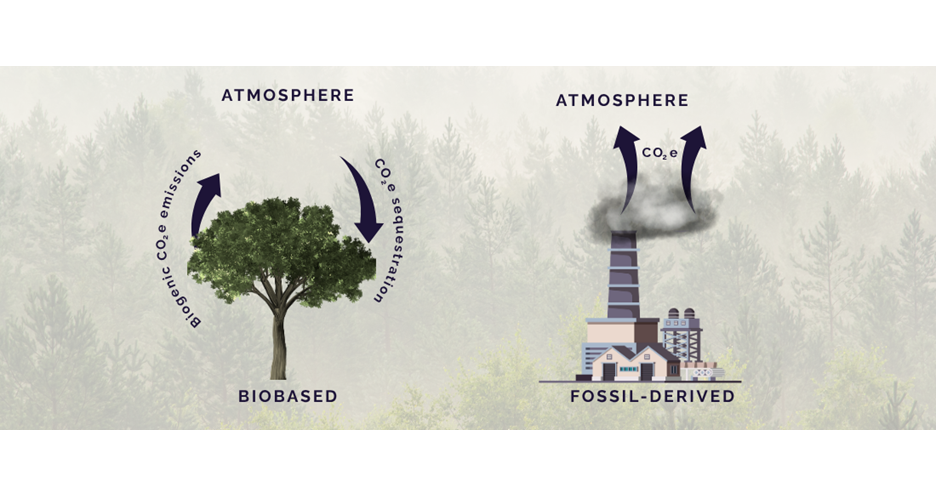Measure it to master it: harnessing biogenic carbon data for sustainable beauty innovation
This marks a major milestone in our transparency journey, providing richer insights into the climate impact of Croda Beauty’s ingredients. The new information will help empower R&D, formulation, and procurement specialists to make more informed ingredient choices and innovate products with less planetary burden while maintaining - or even improving - product efficacy and managing cost pressures.
With more than 1,550 PCF statements available across the Croda Beauty ingredient portfolio, for which more than 80% now provide biogenic carbon and total carbon content information, we’re leading the charge for decarbonisation in the industry.
In this blog, we’ll explore these new data points in greater detail, as well as how they can help you to formulate lower-carbon products and future-proof your portfolio.

Product Carbon Footprint
What’s new? Uncovering your product’s carbon origin story
A PCF measures all emissions associated with the production of a product from cradle-to-gate (i.e. from sourcing to manufacture). It can be used to help to identify any emissions hotspots, allowing brands to take targeted action.
But not all carbon is the same. Renewable materials, such as biobased feedstocks, have a distinct advantage over non-renewable materials when it comes to minimising climate impact: they avoid the additive effect of virgin fossil materials on atmospheric Greenhouse Gas (GHG) levels.
Knowing the origin of the carbon contained within a product therefore allows for a better understanding of the potential downstream Scope 3 emissions that will be emitted when it eventually breaks down. This is where total carbon content comes in. Measured as carbon units per unit of product (such as kg C/kg), it describes the total physical carbon contained within a product and can be divided into subcategories, including:
- Biobased carbon content - The physical carbon contained in the product that is derived from living organisms. This is used to calculate the biobased percentage of the material (biobased carbon content divided by total carbon content) as well as biogenic carbon removals.
- Fossil carbon content - The physical carbon contained in the product that is fossil-derived (or petrochemical), which is non-renewable.
- Recycled carbon content - The physical carbon contained in the product that is from recycled sources such as recycled plastics.
- Carbon capture and utilisation (CCU) content - The physical carbon contained in the product that is from CCU. This is carbon captured from the atmosphere artificially (using technology) and then converted into useful materials.
Of these, it’s important to note that fossil carbon content is the only non-renewable source.
What is biogenic carbon?
Biogenic carbon refers to carbon sequestered by biobased materials (specifically plants via photosynthesis) during growth and released as carbon dioxide or methane when they break down at end-of-life. When released, these emissions will be reabsorbed by future plants during their growth. This cycle happens on ‘human’ timescales, and so there is no overall net impact on atmospheric GHG levels over the lifecycle.
By contrast, fossil-derived materials release carbon emissions that have a much longer lifecycle, with millions of years involved in their creation and geological storage. The fossil-derived carbon that is released therefore only adds to atmospheric GHG levels.
To account for the benefit of sequestered carbon contained in biobased materials, we can calculate the biobased carbon content of a material and, from this, deduce how much CO2 was absorbed from the atmosphere during its growth. This is a biogenic CO2 removal, which can be indicated on a PCF statement as a negative value in carbon dioxide equivalent (CO2e) units per unit of product (such as kgCO2e/kg).

Why biogenic carbon matters in beauty
Every cosmetic ingredient carries a carbon footprint shaped by its life cycle – from raw material extraction and processing through to the manufacture of the finished product. As the market moves in favour of a new, low-carbon economy, it’s important that brands adapt[1].
Including biogenic carbon in the PCF calculation gives a more accurate picture of an ingredient’s climate impact. Without it, the carbon footprint of biobased materials can look similar – or worse – than their fossil-derived alternatives. This is because many petrochemical manufacturing processes are highly efficient following years of optimisation and economies of scale.
However, as soon as biogenic carbon removals and emissions are properly accounted for and the CO₂ removal during biomass growth is acknowledged, the climate advantage of biobased materials becomes visible, and the transparency and integrity of PCF calculations improves; resulting in a richer dataset and a more accurate view of an ingredient’s net climate impact.
Armed with these insights, it becomes easier to strike an optimal balance between performance, sustainability, and cost, and lay the groundwork for mastering sustainability best practices as global standards tighten. This proactive stance ensures your formulations remain compliant, competitive, and truly distinctive in a crowded market.

Aligning with Together for Sustainability: measurement as a competitive edge
Within the chemical market, Together for Sustainability (TfS) is redefining expectations for supplier data transparency and carbon reporting across the value chain. Their methodology aligns with relevant ISO standards (including ISO14044:2006 and ISO14067:2019) and the Greenhouse Gas Protocol and ensures convergence with the new World Business Council for Sustainable Development (WBCSD) Partnership for Carbon Transparency (PACT) v3.0 framework used by many brands worldwide.
By aligning with widely accepted global initiatives, TfS is helping to work towards a consistent standard within the chemical industry. This will be vital for the simplicity and comparability of PCFs moving forwards, allowing brands to trust that the quality of data and methods of calculations used by their suppliers are comparable and representative of methods used by their own in-house teams.
Croda Beauty's PCF method is highly aligned with TfS’ Product Carbon Footprint Guidance v3.0 (2024). By proactively integrating biogenic removals and carbon content subcategories into our PCF calculations, Croda Beauty is preparing for mandatory updates expected in 2025 and 2027 - helping our customers to turn insights into a competitive edge and bolstering today’s efforts to advance sustainability.
Croda Beauty’s methodology was third-party verified prior to the addition of biogenic data in November 2025 and will be re-assessed in 2026 for renewed verification.
From measurement to mastery: cross-functional impacts of biogenic and total carbon data
PCF insights empower brands to design products with a lower carbon impact, supporting informed innovation and climate-conscious choices alongside the high-performance consumers expect.
Croda Beauty’s “Measure it to Master it” initiative embodies this concept. By calculating more than 1,550 PCFs across its portfolio, Croda Beauty and our customers gain visibility to identify emissions hotspots and take targeted action to reduce environmental impact, enabling informed decisions across the value chain. But what does this mean for innovators?
Formulators: designing for climate impact
For formulation scientists, “Measure it to Master it” means you can more confidently deliver against climate metrics in your marketing brief. Beyond texture, stability, and sensory attributes, you can now consider product carbon footprint, including biogenic CO₂e removals in your formulation at the same level of rigor. This holistic view allows you to:
- Identify lower-impact ingredients that match or exceed current performance
- Optimise formulation chassis for maximal carbon savings
- Produce products that marketing teams can consider certifying with third-party, credible eco-labels
By mastering ingredient-level data, formulators can sequence decarbonisation efforts: prioritising high-impact swaps before tackling smaller-volume ingredients. This strategic approach delivers measurable carbon wins early in the product lifecycle, building momentum for more nuanced refinements.
Purchasing: managing Scope 3.1 emissions in supply chains
Procurement specialists, armed with biogenic PCF data, can transform supplier engagement into a strategic tool for risk reduction and long-term value creation, ensuring commercial viability. Measuring each ingredient’s carbon footprint enables you to:
- Source products that meet corporate sustainability targets alongside meeting quality, inventory and budgetary requirements
- Negotiate clear, quantitative upstream Scope 3.1 reduction targets with suppliers
- Leverage data for long-term risk reduction and legislative compliance
While brands benefit from increased upstream transparency in emissions data to complement their cost and performance analysis, transparent carbon requirements foster deeper collaboration with suppliers for feedstock sourcing, processing efficiencies, and joint innovation.
Sustainability professionals: driving progress towards targets
Ingredient-level PCFs feed directly into decarbonisation roadmaps, internal dashboards, and corporate reporting. By incorporating PCFs into Scope 3 carbon accounting, sustainability teams can:
- Gain deeper data granularity to assist in meeting annual reporting requirements
- Understand progress made against company sustainability targets
- Target high-impact ingredient categories
- Prepare for advanced disclosures required by emerging regulations like the EU Corporate Sustainability Reporting Directive
Mastery of this data transforms reporting from a compliance checkbox into a strategic narrative, showcasing concrete, ingredient-scale achievements in carbon reduction.
Marketers: crafting credible, data-driven claims
In a market saturated with “green” claims, substantiation is key. PCF data, calculated in high alignment with industry standards (such as those set out by TfS), gives marketing teams the substantiated data needed to differentiate products.
By mastering and then utilising these insights, you can:
- Highlight precise carbon savings in consumer materials, working with credible organisations to build data packs for their finished products
- Tailor climate narratives to audience needs
- Elevate brand positioning and build trust through transparency
From social media campaigns to on-pack labels, clear and objective data resonates with today’s consumers who demand both authenticity and accountability in their beauty products.
Measure it to master it: your next steps
The path to truly sustainable beauty begins with understanding the data. Request your PCF statement today or find out about the steps we’re taking to decarbonise our operations.
References
[1] Euromonitor (2024) Unlocking Sustainability Opportunities in Beauty and Personal Care

